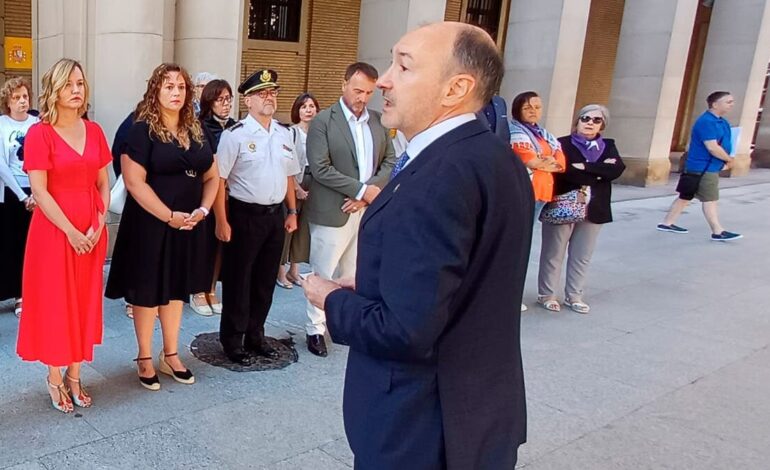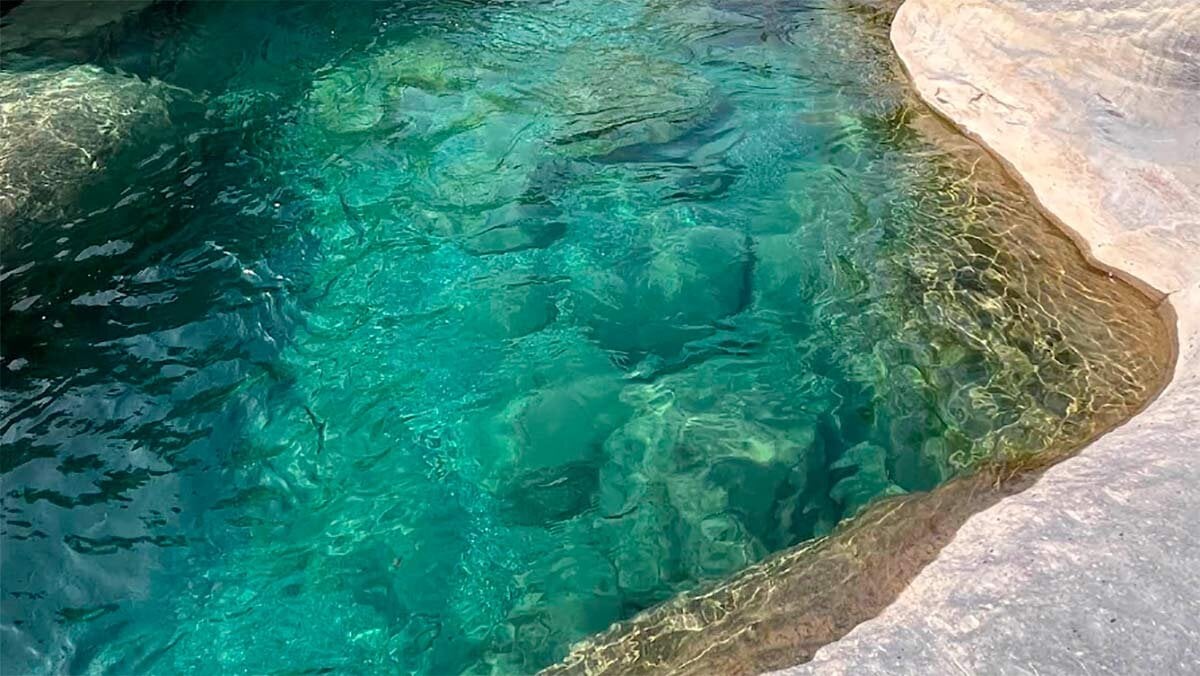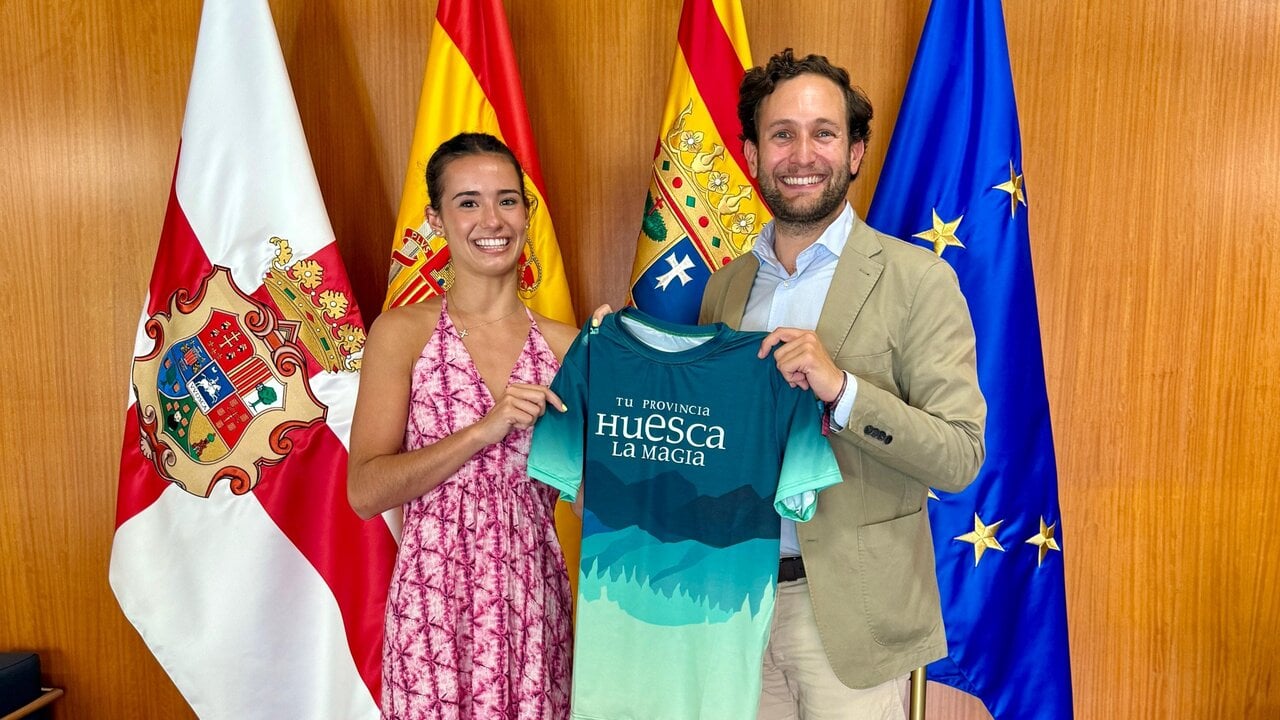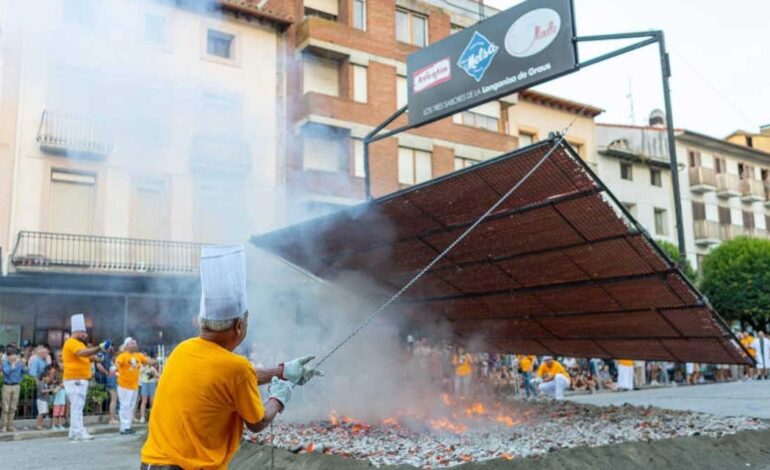
It has a giant grill hanging from a crane: the town of Huesca with a Guiness and Waters record
Aragonese gastronomy is recognized for its authentic flavor and variety, where each dish is recognized as a real delicacy. The ternasco, the cherries, the boots, the artisan sausages such as chorizo or sausage, and the exquisite cheeses are just some of the delights that conquer those who visit Aragon.
A perfect example of this rich culinary culture is the Longaniza de Graus party, which is celebrated every year on the last Saturday of July. This event stands out for its sausage but does not stay there, in turn offers a unique experience where gastronomy, music and good atmosphere attract thousands of visitors every year.
In addition to the party, Graus has a medieval old town, aquatic sports in the brave waters of the Osra river, the Museum of the icons, with a unique collection of sacred art and much more.
The Guinnes record grill at the Graus sausage party
What to do and what to do in Graus
The Guinnes record grill at the Graus sausage party
The Longaniza de Graus party, declared of tourist interest in Aragon in 2013, is one of the most anticipated events of the year. Held annually since 1991, always coincides with the last Saturday of July. During the party, Graus’s sausage, one of the most representative products of Aragonese cuisine, is the protagonist.
How key activity highlights the largest grill in the world, a moment of great emotion when a crane elevates the 25 -square -meter grill to cook more than 1,100 kilos of sausage, which is why since 1997 the Guinnes record holds. A show for attendees.
The party program is varied and has activities for the whole family. From the sausage Fest with tapas and live music to the artisan market, which is celebrated in the streets of the municipality. Attendees can also enjoy children’s workshops, competitions.
What to do and what to do in Graus
In addition, from this barbecue, Graus has more to offer: from its impressive museum of the icons, its local architecture to their natural landscapes, perfect for outdoor activities and water sports.
Ancient Casco de Graus
The old town of this town, declared a historical complex in 1975, is a reflection of its rich medieval past, with architectural strokes and structures that have endured over time. In their walls you can still distinguish sections that remember their strength and defense, and three of its historical doors: Chinchín, Lyés and Barón, remain as witnesses of the old entrance to the city. Through its narrow streets and squares, which still retain the medieval flavor of its origin, you can relive the atmosphere of past times.
In the neighborhood known as Barrichós, also called El Barrio de Abajo, the essence of this historical enclave is preserved, where stately palace houses such as those of Mur, Solano, Oliván, Torquemada, Oncino and Fantón are raised, reflecting the richness of the families that inhabited these lands in times of splendor. Every corner invites to immerse yourself in history, exploring its facades, buildings and streets that have maintained their authenticity throughout the centuries. This space is a reference of medieval heritage, which attracts both lovers of history and those interested in cultural tourism.
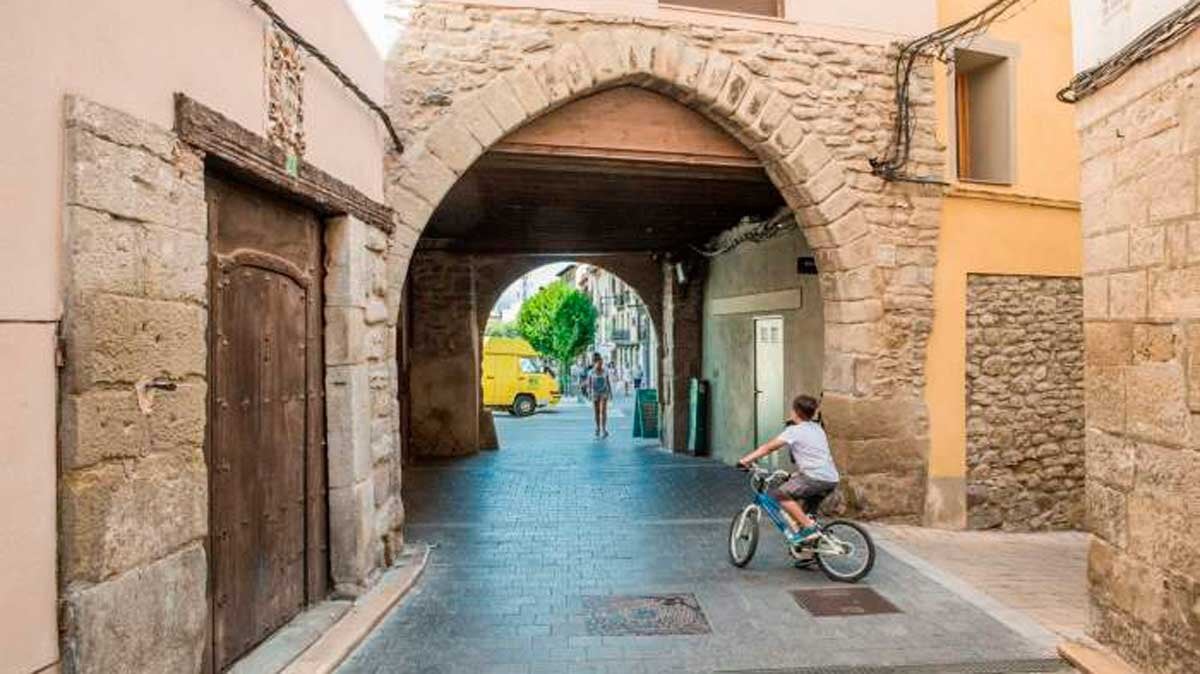
The old town of this town, declared a historical set in 1975, is a reflection of its rich medieval past. Photo: Aragon Tourism
Museum of icons
The Graus icons museum is one of the most unique cultural spaces in the province of Huesca. Located in the Basilica of the Virgen de la Peña, the Museum houses an extraordinary collection of religious icons that represent various traditions and iconographic schools, both from the East and the West. This fascinating exhibition includes original reproductions and pieces from countries such as Russia, Greece, Chipre, Poland, Ukraine and many more, which allows visitors to know thoroughly the wealth and diversity of Eastern sacred art.
From the Romanesque to the nineteenth century, the exposed icons allow to appreciate the evolution of Orthodox Christian iconography and its importance in the spirituality of the peoples of Eastern Europe. Graus offers not only a historical and cultural visit, but also a unique experience for lovers of religious art. Visitors can explore the museum through guided tours, which will allow them to know every detail of the pieces and their historical context, while enjoying the panoramic views from the Basilica cloister.
The museum opens its doors every day, with special schedules during the high season. From September to March, the museum is available from 10:00 a.m. to 5:00 p.m., while from April to August it extends its schedule until 8:00 p.m., in addition the entrance is free.
Basilica of the Virgen de la Peña
The Basilica of the Virgen de la Peña in Graus is one of the most representative monuments of the town, with a Romanesque origin and a rich history that also covers the Gothic and the Renaissance. This robust church with a single ship stands out for its starry cruise vaults, one of the most impressive architectural characteristics of the temple. In addition, the Basilica houses a cloister of great beauty and an old hospital, where the museum of icons is located, one of the most unique collections in the region. From the Basilica gallery, visitors enjoy exceptional panoramic views about Graus urbanism and the valleys of the ESERA and Isábena.
Open every day of the year, the Basilica of the Virgen de la Peña has a visiting schedule from 10 am to 5 pm from September to March, and from 10:00 a.m. to 8:00 p.m. from April to August, with free admission. It is a place of great interest to those who seek Huesca.
Graus Parish Church
The parish church of San Miguel in Graus, of Romanesque origin, has witnessed multiple transformations over the centuries. Although its current structure has evolved until the eighteenth century, it still retains vestiges of its medieval foundation, such as the central nave and the Romanesque cinnamons, while the lateral warehouses were added in the fourteenth century, showing the Gothic influence. This temple is not only a point of architectural interest, but also a place of great religious relevance, since the Holy Christ houses, a crucifix donated by San Vicente Ferrer in 1415, patron of the town.
The baroque chapel of the Holy Christ, built in 1730, is one of the most prominent elements of the Church and attracts numerous visitors every year. In it is the image of the Holy Christ, which was partially destroyed during the civil war and restored in the late forties. The Church also houses a series of valuable Gothic tables, currently deposited in the Barbastro-Monzón Diocesan Museum.
About half an hour before Saturday masses (7.30 pm) and Sundays (12.00 and 7.30 pm). Free admission.
Water sports in Graus
The brave waters of the Estra river, when descending from the Pyrenees and crossing close congosses, offer the perfect scenario for adrenaline aquatic sports fans. In Graus, you can enjoy a unique experience with activities such as Rafting, Hidrospeed and Kayak, where direct contact with nature becomes an exciting experience for all adventurers. Fast and impressive views make this destination an unbeatable place for sports in brave waters.
If you prefer a quieter atmosphere, the Joaquín Costa or Barasona reservoir is the ideal place. Known as an “inner sea”, this reservoir allows you to enjoy water sports in calm waters, such as aquatic skiing, Windsurf, or a relaxing canoeing or hydropedal walk. Only 5 km from Graus, the nautical base becomes the perfect site to enjoy a relaxed summer day, surrounded by impressive natural landscapes.
Dag Shang Kagyu Buddhist Center in Panillo
Only 10 km from Graus, in the picturesque municipality of Panillo, is the Dag Shang Kagyu Buddhist center, a peace haven that offers a unique spiritual connection experience in the heart of the Aragonese Pyrenees. Founded in 1984 by Kyabje Kalu Rinpoche, this center belongs to the Kagyu Tibetan tradition and is the main headquarters of the Shangpa Kagyu lineage in Europe.
The center is composed of a main temple of traditional Tibetan style, a 17 -meter -high stupa and a shadra (school) dedicated to the study of Buddhism. Visitors can explore the enclosure on their own for free, respecting the atmosphere of silence and contemplation that characterizes the place.
The center offers guided visits on weekends at 11.30 and 13.00, with an approximate duration of an hour. The cost is 3 euros per person, being free for children under 7 years. It is not necessary to reserve in advance, but it is recommended to arrive at least 20 minutes in advance to sign up for the temple secretariat.
Patron Saint Festivities of the Holy Christ
The patron saint festivities of Santo Cristo and San Vicente Ferrer, held in Graus (Huesca) during the month of September, are one of the most prominent festivities in Aragon. Declared of national tourist interest in 1973, these celebrations combine religious devotion and popular traditions that have endured over the centuries.
One of the most emblematic acts is Mojiganga, a satirical representation that runs through the streets of Graus and culminates in the Plaza Mayor with a critical and humorous performance about the events of the year. This event, which is held on September 13, is the most massive parties and has the active participation of the inhabitants of the town.
The Mojiganga has its roots in the seventeenth century and was recovered as a festive tradition in 1979. Its burlesque character has led to the fact that at some times its celebration has been banned, as during the French invasion or the Government of Primo de Rivera until 1977.
In addition to the Mojiganga, the holidays include other traditional acts such as the dances, the fold, the albadas and the presence of characters such as the giants, the big heads, the masks, the Cabalz and the furta. These events are developed in various spaces of Graus, such as the Plaza Mayor, the Basilica of the Virgen de la Peña and the Parish Church of San Miguel, creating a unique atmosphere that attracts both premises and visitors.
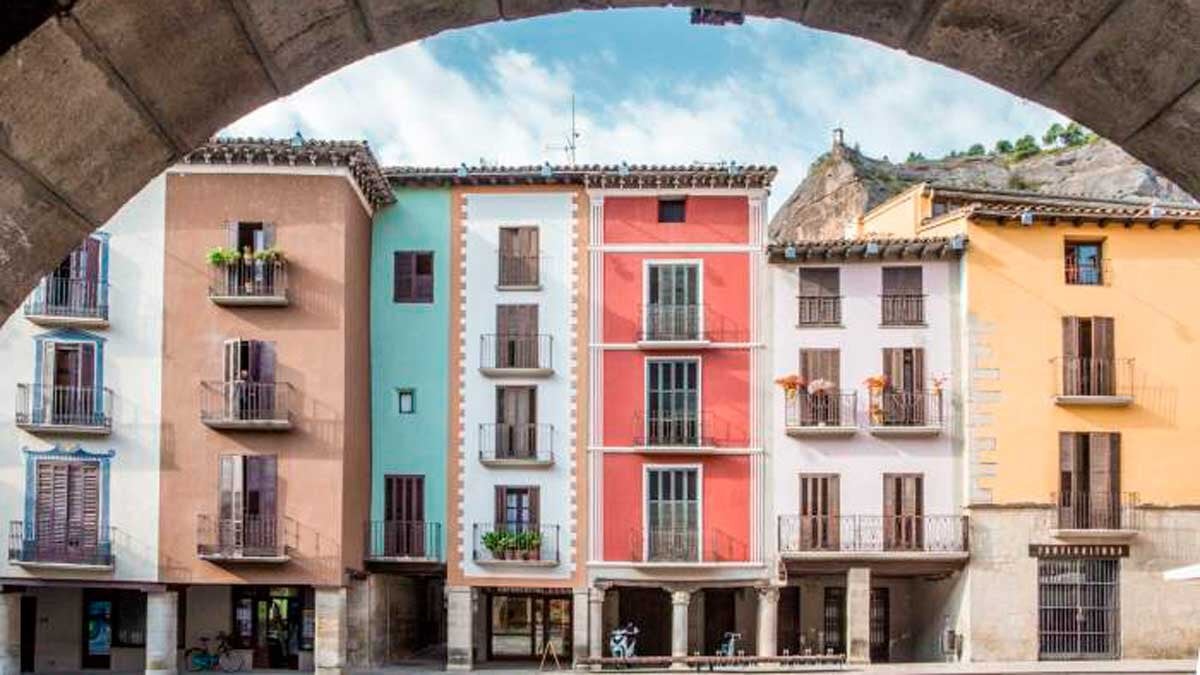
Graus is located in the region of La Ribagorza. Photo: Aragon Tourism
How to get to Graus
From Saragossa
Zaragoza’s journey to Graus by car is 1 hour and 49 minutes. The best way to go from Zaragoza to Graus without a car is by bus that lasts 3 hours and 14 minutes and costs between 13 and 25 euros.
From Huesca
The distance from Huesca to Graus is approximately 1 hour and 4 minutes by the A-22, if you go by car. The Bus from Huesca to Graus takes 1 hour 6 minutes and costs from 7 euros.
From Teruel
The distance from Huesca to Graus is approximately 3 hours and 18 minutes for the A-23 by car. The best way to go from Teruel to Graus without a car is by bus that lasts 6h 18min and costs 21 and 40 euros or other option is by train that costs about 5 hours and 35 minutes.

